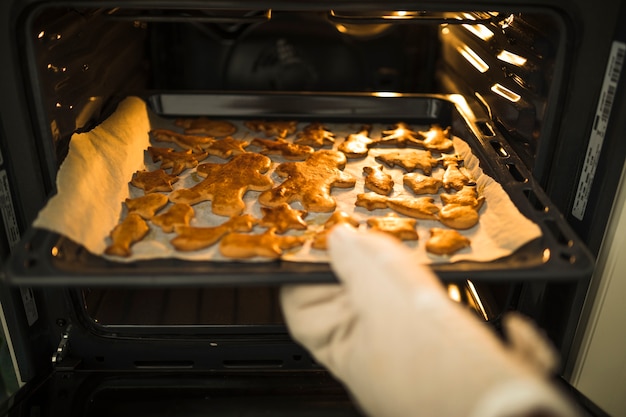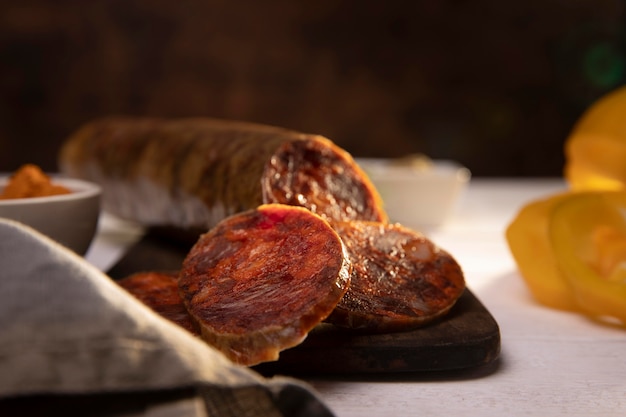(Part 1) Choosing Your Ham: A Tale of Two Cuts

1. bone-in ham: The Classic Choice
Bone-in hams, as the name suggests, come with the bone intact. This, in my opinion, is the way to go! The bone adds a lovely depth of flavour and helps keep the ham moist during cooking. Plus, you can always use the bone to make a delicious stock later.2. boneless ham: Convenience Rules
Boneless hams are often pre-sliced and are perfect for a quick meal. They are generally smaller and easier to carve, but they can sometimes be a little drier than their bone-in counterparts. So, if you're short on time or want a less-messy carving experience, boneless is a solid option.Personally, I'm a bone-in ham devotee. The flavour and texture are simply unmatched, but ultimately, the choice is yours!(Part 2) Prepping Your Ham: Getting Ready for the Roast

1. Removing the Ham Skin: A Crucial Step
If you're working with a bone-in ham, the first step is to remove the skin. Don't be intimidated! It's quite simple. I find it easier to score the skin in a criss-cross pattern with a sharp knife, then peel it back. You can toss the skin or save it to make a flavorful stock.2. Scoring the Fat: Unleashing the Flavour
Next, we're going to score the fat on the ham. This step allows the fat to render during cooking, adding moisture and richness to the meat. Use a sharp knife to make shallow cuts, about 1/2 inch apart, across the fat surface.3. Adding Flavour: The Fun Part Begins
Now comes the fun part! Experiment with flavours and create your own signature ham roast. I often rub the ham with a mixture of Dijon mustard, brown sugar, and garlic powder. It's a classic combination that delivers a sweet and savory punch. But feel free to get creative! Try honey and cloves for a touch of sweetness, or smoked paprika and black pepper for a smoky kick.(Part 3) Roasting Your Ham: The Heart of the Operation

1. Oven Temperature: Setting the Stage for Success
Preheat your oven to 325°F (160°C). This is the standard temperature for roasting ham and helps ensure even cooking throughout.2. roasting time: A Guide for Different Sizes
Cooking time depends on the size and weight of your ham. A good rule of thumb is to allow 15 to 20 minutes per pound of ham. So, for a 10-pound ham, you'd be looking at a roasting time of 2.5 to 3.5 hours. However, always check the package instructions for specific cooking times as they might provide more accurate estimates for your particular ham.3. Ham Placement: A Strategic Move
Place your ham in a roasting pan, fat side up. Make sure it sits comfortably on a trivet or rack so that air can circulate evenly around it. This helps ensure that the ham cooks evenly and doesn't stick to the bottom of the pan.4. Basting the Ham: A Key to Juiciness
During the roasting process, you'll want to baste your ham every 30 minutes to keep it moist and add more flavour. I use a basting brush to apply a mixture of water, apple cider, or even my favourite glaze. This will create a beautiful golden crust and ensure your ham stays juicy.(Part 4) Checking for Doneness: When to Take It Out
No one wants a dry, overcooked ham, so it's important to know when your ham is perfectly cooked. There are a few ways to check for doneness:1. Using a meat thermometer: The Gold Standard
This is my preferred method. Use a meat thermometer to check the internal temperature of the ham. Insert it into the thickest part of the ham, making sure it doesn't touch the bone. The internal temperature should reach 145°F (63°C) for a safe and delicious ham.2. Visual Inspection: Clues to Doneness
If you don't have a meat thermometer, you can also check for doneness visually. The ham should be cooked through, with a golden-brown colour. The juices should run clear, and the fat should be rendered.(Part 5) Resting the Ham: The Crucial Cooling PeriodOnce your ham is cooked, don't rush to carve it! Allow it to rest for at least 15 minutes. This gives the juices a chance to redistribute throughout the meat, resulting in a more tender and juicy ham. I find this resting period is essential for achieving the best results.(Part 6) Carving the Ham: A Simple GuideCarving a ham can seem daunting, but it's actually pretty straightforward. Use a sharp carving knife to slice the ham into thin pieces. If you're working with a bone-in ham, start by carving away the meat from the bone. Then, slice the ham across the grain for the best texture.(Part 7) Serving and Storing Leftovers: Making the Most of Your HamYour perfectly cooked ham is now ready to be served! It's delicious both hot and cold. I love serving it with a side of mashed potatoes, roasted vegetables, and a generous drizzle of gravy. But let's be real, there's always some leftover ham! And that's a good thing! You can store leftovers in the fridge for up to four days. For longer storage, you can freeze it for up to three months. Just make sure to wrap it tightly in plastic wrap and then foil to prevent freezer burn. (Part 8) ham glazes: Elevate the FlavourHam glazes are the finishing touch that really elevates the flavour of your roast. They add a layer of sweetness, tang, and complexity that will have your guests raving. Here are a few of my favourite ham glaze recipes:
(Part 7) Serving and Storing Leftovers: Making the Most of Your HamYour perfectly cooked ham is now ready to be served! It's delicious both hot and cold. I love serving it with a side of mashed potatoes, roasted vegetables, and a generous drizzle of gravy. But let's be real, there's always some leftover ham! And that's a good thing! You can store leftovers in the fridge for up to four days. For longer storage, you can freeze it for up to three months. Just make sure to wrap it tightly in plastic wrap and then foil to prevent freezer burn. (Part 8) ham glazes: Elevate the FlavourHam glazes are the finishing touch that really elevates the flavour of your roast. They add a layer of sweetness, tang, and complexity that will have your guests raving. Here are a few of my favourite ham glaze recipes:
1. Maple-Honey Glaze: A Sweet and Savory Delight
1/2 cup maple syrup 1/4 cup honey 1 tablespoon Dijon mustard 1 teaspoon ground gingerCombine all ingredients in a saucepan and bring to a simmer. Brush the glaze over the ham during the last 30 minutes of cooking.2. brown sugar glaze: Classic and Comforting
1/2 cup brown sugar 1/4 cup apple cider vinegar 1 tablespoon Dijon mustard 1 teaspoon ground clovesCombine all ingredients in a saucepan and bring to a simmer. Brush the glaze over the ham during the last 30 minutes of cooking.3. pineapple glaze: Tropical Twist
1/2 cup pineapple juice 1/4 cup brown sugar 1 tablespoon soy sauce 1 teaspoon ground gingerCombine all ingredients in a saucepan and bring to a simmer. Brush the glaze over the ham during the last 30 minutes of cooking.(Part 9) Ham Cooking Times Table: A Quick ReferenceHere's a table to summarise ham cooking times based on weight:
| Ham Weight (lbs) | Cooking Time (hours) |
|---|---|
| 4-6 | 1.5-2 |
| 7-9 | 2-2.5 |
| 10-12 | 2.5-3 |
| 13-15 | 3-3.5 |
| 16-18 | 3.5-4 |
(Part 10) FAQs: Answering Your Ham QuestionsLet's answer some frequently asked questions about roasting ham:
1. Can I Cook a Ham From Frozen?
You can cook a ham from frozen, but it will take longer. Allow an extra 30 minutes per pound of ham for cooking time. Make sure the ham is thawed completely before carving and serving.2. What If My Ham is Too Salty?
If your ham is too salty, try soaking it in cold water for a few hours before cooking. This can help to draw out some of the salt. You can also add a little more sweetness to your glaze to balance out the saltiness.3. What Can I Do With Leftover Ham?
Leftover ham is a culinary treasure! You can use it in sandwiches, salads, soups, and even casseroles. Get creative and experiment with different flavours.4. Can I Reheat a Cooked Ham?
Absolutely! You can reheat a cooked ham in the oven, microwave, or slow cooker. For the oven, place it in a baking dish and cover it with foil. Reheat it at 325°F (160°C) for about 15-20 minutes. For the microwave, slice the ham into thin pieces and microwave on high for about 30-60 seconds. And if you're using a slow cooker, set it on low for 2-3 hours.5. Is It Safe to Eat Ham That's Been Out of the Fridge for a While?
It's best to keep cooked ham refrigerated. Once it's been out of the fridge for more than two hours, it's not safe to eat. To be extra safe, throw away any cooked ham that has been left out at room temperature for more than two hours, especially in warmer weather. With these tips and tricks, you'll be able to roast the most delicious ham, every single time. So go forth and impress your family and friends with your newfound ham roasting expertise!Everyone is watching

Corn on the Cob: The Ultimate Guide to Perfectly Cooked Ears
Healthy MealsAh, corn on the cob. Just the name evokes images of sunny days, barbecues, and that sweet, juicy flavour that ...

Perfect Pork Roast Oven Cooking Time: A Guide to Delicious Results
Healthy MealsThere's something truly satisfying about a perfectly roasted pork. The aroma alone is enough to make your mout...

Ham Cooking Time: How Long to Bake, Smoke, or Boil a Delicious Ham
Healthy MealsAh, ham. It's a classic, isn't it? A real crowd-pleaser, especially around holidays. And when done right, it'...

Scallops: The Ultimate Guide to Perfect Cooking
Healthy MealsAh, scallops. Those delicate, sweet, and utterly delicious morsels of the sea. They hold a special place in my...

Spaghetti Squash: The Ultimate Guide to Cooking and Serving
Healthy MealsRemember that time you saw spaghetti squash at the supermarket, looking all bumpy and strange, and thought, "W...
